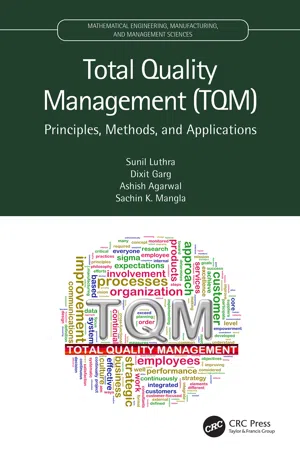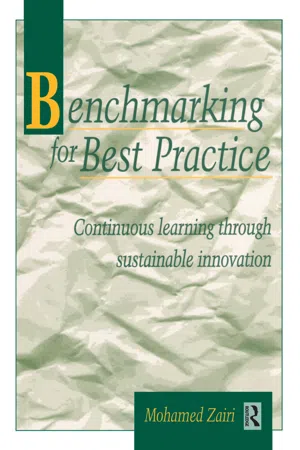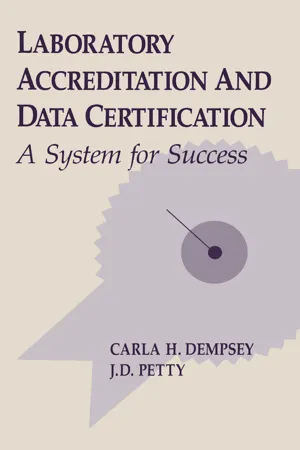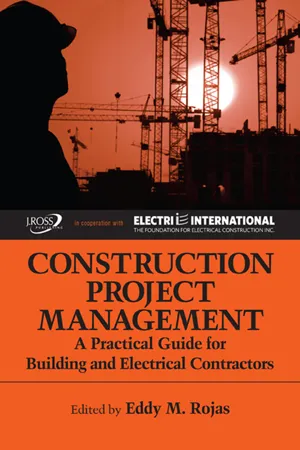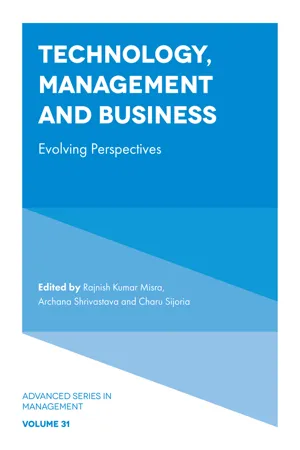Business
Evaluating Total Quality Management
Evaluating Total Quality Management involves assessing the effectiveness of TQM practices within an organization. This includes measuring performance against established quality standards, identifying areas for improvement, and gathering feedback from employees and customers. The evaluation process aims to ensure that TQM initiatives are contributing to enhanced quality, customer satisfaction, and overall business success.
Written by Perlego with AI-assistance
Related key terms
Related key terms
1 of 4
Related key terms
1 of 3
10 Key excerpts on "Evaluating Total Quality Management"
- eBook - ePub
Total Quality Management (TQM)
Principles, Methods, and Applications
- Sunil Luthra, Dixit Garg, Ashish Agarwal, Sachin K. Mangla(Authors)
- 2020(Publication Date)
- CRC Press(Publisher)
2 Total Quality Management (TQM)2.1 DEFINITION OF TOTAL QUALITY MANAGEMENT (TQM)
Total Quality Management (TQM) seeks to integrate all organisational functions, such as marketing, finance, design, engineering, production, customer service, etc. to focus on meeting customer needs and organisational objectives.TQM is defined as:- Total = Made up of the whole.
- Quality = Degree of excellence of product/service provider.
- Management = Art of handling, controlling and directing.
TQM sees an organisation as a set of processes. It argues that organisations must strive to continually improve these processes by integrating the knowledge and experiences of workers. The simple goal of TQM is ‘To do things right, the first time, always.’ TQM is infinitely variable and adaptable. This management approach covers several areas, although it was originally applied to manufacturing operations. For several years, it has only been used in this field. From now on, TQM is identified as a generic management tool, which also applies to services (health and safety), industrial enterprises, and the public sector. There is a series of evolutionary units, with different sectors creating their own versions of the common predecessor.Total Quality Management is also defined as a customer-driven process and goals for continuous improvement of business operations. It ensures that all related work (in particular the work of the employees) is directed towards the common objectives of improving the quality of the product or the quality of the service, as well as the production or execution process of the services. However, the focus is on evidence-based decision-making, with the use of performance measures to monitor progress (Deming). - eBook - ePub
Construction Management
New Directions
- Denny McGeorge, Patrick X. W. Zou(Authors)
- 2012(Publication Date)
- Wiley-Blackwell(Publisher)
Of all of the concepts outlined in this book, TQM is one of the broadest and most wide ranging. In some ways it is an umbrella under which many other concepts are encompassed. As with other concepts in this book, there is no single accepted definition of TQM. Rampsey and Roberts [8], define TQM as:… a people focused management system that aims at continual increase in customer satisfaction at continually lower real cost. TQM is a total system approach (not a separate area or program), and an integral part of high level strategy. It works horizontally across function and department, involving all employees, top to bottom, and extends backwards and forwards to include the supply chain and the customer chain.(Interestingly, the construction industry invariably uses the word ‘client’ as opposed to ‘customer’ to describe a purchaser of good services, perhaps on the basis that ‘client’ has more sophisticated connotations than ‘customer’. In Webster’s Dictionary [9], these words are given as synonymous with one another.)In our view Rampsey and Roberts’ definition encompasses the fundamental principles of TQM. First, TQM must be a total approach to quality. Whereas in the past quality was concerned with parts of the organisation, such as the final product or customer relations, TQM is concerned with the whole system as an integrated unit. Second, TQM is ongoing. Whereas in the past quality was viewed as a system that could be put in place to improve certain sections of the product or organisation, TQM is a continuous process. The view is now taken that, however good a system has become, it can always be improved further. Finally, the goal of TQM is customer satisfaction. In the past, quality systems have been aimed towards improving products, not customer satisfaction. These are not necessarily the same thing, since it is possible to improve a product without realising that it is not in fact what the customer wants. - eBook - ePub
- Mohamed Zairi(Author)
- 2010(Publication Date)
- Routledge(Publisher)
3 Critical factors for effectiveTQM implementation: abenchmarking approach
When your strategy is deep and far-reaching then what you gain by your calculations is much, so you can win before you even fight. When your strategic thinking is shallow and nearsighted, then what you gain by your calculations is little, so you lose before you do battleSun Tzu – The Art of War3.1 Introduction
Total Quality Management (TQM) is one of the subjects which tends to raise many questions about meaning and benefits, and eventually about enhancing competitiveness through supporting financial results. Although it is widely agreed that TQM has to be defined in customer terms, organizations tend to take various routes, adopt different approaches and exhibit varying degrees and levels of commitment.A definition of TQM which takes an organization-wide approach was suggested by the author and his colleagues for the purpose of a study on TQM impact on bottom line results[1 ].A positive attempt by the organizations concerned to improve structural, infrastructural, attitudinal, behavioural and methodological ways of delivering to the end customer, with emphasis on: consistency, improvements in quality, competitive enhancements, all with the aim of satisfying or delighting the end customer.The above definition is meant to include a wide range of critical factors which cover the following:Leadership elements:• Mission/vision statement. • Quality policy. • Direction. • Goals. • Communication processes. • Measurement. • Quality decisions. • Strategic planning and deployment. • Customer/market focus.Hard elements:• Tools and techniques. • Measurement. • Systems. • Procedures. • Specifications. • Standards.Soft elements:• Problem-solving approach. • Teamwork. • Innovation/creativity. • Continuous improvement philosophy. • Empowerment. - eBook - ePub
Total Quality Management
Text, Cases, and Readings, Third Edition
- Joel E. Ross(Author)
- 2017(Publication Date)
- Routledge(Publisher)
external customers. An enlarged definition of quality should be used to embrace all business processes, rather than just manufacturing.The systems approach, by definition, requires the integration of organizational activities for achievement of a common goal. This goal, under the TQM form of organization, remains the satisfaction of customer requirements, but customers are now considered to be both outside as well as within the organization.23 The process applies whether relating to a final customer or an internal customer; it is a participative process involving supplier and customer in an active dialogue. Examples include:■ Metropolitan Life Insurance Company has made a major commitment to improve quality by implementing a horizontal management approach that is built on management commitment, employee involvement, and knowledge of internal suppliers.24■ Campbell USA has aimed its latest quality emphasis, its “Quality Proud” program, at the administrative and marketing activities of the company. Job descriptions, promotions, pay, and bonuses for all employees are linked to the results of the new program.25As a major step in its transformation to a total quality organization, DEC asked each of its 125,000 employees to answer in writing the following questions: 1. What business process are you involved in? 2. Who are your customers (that is, the next step in the processes you are involved in)? 3. Who are your suppliers (that is, the preceding step in the processes you are involved in)? 4. Are you meeting the expectations of your customers? 5. Are your suppliers meeting your expectations?6. How can the processes be simplified and waste eliminated?26■ DEC reported that this simple survey had a massive impact In the short run, countless redundant activities were discovered and eliminated. In the long run, DEC employees now think in terms of meeting both internal and external customer expectations. (This concept is also illustrated in Figure 9-2. - eBook - ePub
- Jens J. Dahlgaard, Ghopal K. Kanji, Kai Kristensen(Authors)
- 2008(Publication Date)
- Routledge(Publisher)
Introduction to Quality Engineering, American Supplier Institute, Dearborn, Michigan, USA.Passage contains an image
4 Philosophy, priniciples and concepts of TQM
TQM is a vision which the firm can only achieve through long-term planning, by drawing up and implementing annual quality plans which gradually lead the firm towards the fulfilment of the vision, i.e. to the point where the following definition of TQM becomes a reality:A corporate culture characterized by increased customer satisfaction through continuous improvements, in which all employees in the firm actively participate.Quality is a part of this definition in that TQM can be said to be the culmination of a hierarchy of quality definitions:- Quality—is to continuously satisfy customers’ expectations.
- Total quality—is to achieve quality at low cost.
- Total Quality Management—is to achieve total quality through everybody’s participation.
TQM is no inconsequential vision. At a time when most domestic and overseas markets are characterized by ‘cutthroat competition’, more and more firms are coming to realize that TQM is necessary just to survive. Today, consumers can pick and choose between a mass of competing products—and they do. Consumers choose the products that give the ‘highest value for money’, i.e. those products and services which give the highest degree of customer satisfaction in relation to price. - eBook - ePub
- Frank Voehl(Author)
- 2017(Publication Date)
- Routledge(Publisher)
mutual feedback and close interaction of departments. Engineers, for example, work closely with construction crews and storekeepers to ensure that their knowledge is passed on to workers. Workers, in turn, feed their practical experience directly back to the engineers. The information interchange and shared commitment to product quality is what makes total quality work. Teaching all employees how to apply process control and improvement techniques makes them party to their own destiny and enables them to achieve their fullest potential.However, total quality is more than an attempt to make better products; it is also a search for better ways to make better products. Adopting the total quality philosophy commits the company to the belief that there is always a better way of doing things, a way to make better use of the company’s resources, and a way to be more productive. In this sense, total quality relies heavily upon value analysis as a method of developing better products and operations in order to maximize value to the stakeholder, whether customers, employees, or shareholders.Total quality also implies a different type of worker and a different attitude toward the worker from management. Under total quality, workers are generalists rather than specialists. Both workers and managers are expected to move from job to job, gaining experience in many areas of the company.Defining Total QualityFirst and foremost, total quality is a set of philosophies by which management systems can direct the efficient achievement of the objectives of the organization to ensure customer satisfaction and maximize stakeholder value. This is accomplished through the continuous improvement of the quality system, which consists of the social system, the technical system, and the management system. Thus, it becomes a way of life for doing business for the entire organization.Central to the concept is the idea that a company should design quality into its products, rather than inspect for it afterward. Only by a devotion to quality throughout the organization can the best possible products be made. Or, as stated by Noriaki Kano, “Quality is too important to be left to inspectors.”1Total quality is too important to take second place to any other company goals. Specifically, it should not be subsidiary to profit or productivity. Concentrating on quality will ultimately build and improve both profitability and productivity. Failure to concentrate on quality will quickly erode profits, as customers resent paying for products they perceive as low quality. - eBook - ePub
Laboratory Accreditation and Data Certification
A System for Success
- Carla H. Dempsey, Jimmie D. Petty(Authors)
- 2020(Publication Date)
- CRC Press(Publisher)
Quality programs are still the keys to quality improvement and management. However, management’s understanding of quality assurance is changing. Now, quality functions are no longer relegated to an inspection department. In the past, much emphasis was placed on evaluating products according to static requirements. Today, the emphasis has changed to improving quality and constantly meeting more stringent quality requirements. This is quite a challenge, and a much bigger job than past practices of compliance with static requirements. This planning of design, planning of production, and planning of inspection is a management function. The process of discovering all waste and error in processes is a management function. The term total quality management is a reflection of this change in status for quality assurance functions.The ways of measuring quality expenses are improving. As a result of knowing better the actual cost that errors and rework represent, management’s attention is becoming more focused on prevention of quality problems, rather than fixing the problems after they have occurred.4 The management of the entire process of better design, better production, and better and less need for inspection is now called total quality management.The quality control manager is no longer the “keeper of quality” but is rather a facilitator and teacher that assists each person in understanding what quality is and how to improve quality in their own discipline, specialty, and functional area. This change in thinking about quality from seeing it as a function in the company to a focus of the company is integral to the long term improvement of our companies. The transformation to managing with quality as a focus requires a new set of principles for operating in this new business climate.UNDERSTANDING TOTAL QUALITY MANAGEMENT — DEMING’S FOURTEEN POINTS
W. Edwards Deming5 has provided an easy to understand set of principles that are commonly known as Deming’s 14 points to management. Deming is well known as a leader in the quality disciplines and is noted for his understandable and forthright style of educating managers on effective means to manage for quality. He also points out clearly in his teachings that managers are responsible for the company quality function. His approach of management for continuous improvement of quality leads to lower cost, improved quality, and higher productivity. Deming and other quality professionals such as Joseph M. Juran6 and Kaoru Ishikawa7 - eBook - ePub
Construction Project Management
A Practical Guide for Building and Electrical Contractors
- Eddy Rojas(Author)
- 2009(Publication Date)
- J. Ross Publishing(Publisher)
As a way of documenting your firm’s TQM program and progress, a quality manual can be assembled and used as a reference guide by employees. This quality manual can include the firm’s mission statement, strategic goals, quality policy, and other important information regarding the firm’s direction and policies. In addition, the manual can contain information regarding organizing and managing the TQM process and teams within the firm. Forms, checklists, and examples of the use of analysis tools and techniques can also be included. This manual should evolve over time as the firm’s TQM program matures and will be especially helpful in describing your firm’s TQM program to outsiders and integrating new employees into the firm.ORGANIZING FOR QUALITY
The organizational process involves identifying the processes to be performed to satisfy the objective, assigning responsibility for those processes to particular roles, and providing the procedures to coordinate the many processes to produce the objectives. The complexity of most processes is such that individuals in a single role cannot know enough about all the parts of the process to understand where the greatest combination of changes can produce the greatest results. A team approach makes sense, involving the individuals who have the necessary knowledge about the processes to make the improvement.The steps necessary in the process of organizing for quality vary depending on the current state of the firm. For firms with a rigid hierarchical, autocratic organizational structure and strong functional orientation, the first step is to modify the organization. Many firms have a traditional military command and control structure with rigid boundaries between functional groups. In this case, a new organization or shadow organization may need to be established.In firms that already have adopted a team management style, the task is one of assessing the adequacy of the team, the nature of the current relationships, and the effectiveness of the communication channels to start the TQM process. Usually these firms are ready to begin the process of education, planning, and leading. With a team management approach there has already been recognition of the need for empowerment by at least a few key principals. Among modern firms that say they have a team management approach, most have team management only at the top of the organization rather than throughout. - eBook - ePub
Total Quality Management in Higher Education
Study of Engineering Institutions
- Sayeda Begum, Chandrasekharan Rajendran, Prakash Sai L., K. Ganesh, Sanjay Mohapatra(Authors)
- 2020(Publication Date)
- Routledge India(Publisher)
Section 3.1 ) definitely indicate the importance of top management’s role in demonstrating the desired outcomes in an institution. Top management (service provider) cannot work in a vacuum. The parameters of excellence through which the institution’s progress can be achieved needs to be defined. This work explores 27 critical dimensions of TQM, which form the support for accomplishing institutional performance. Five measures of institutional performance have been indexed to quantify institutional performance.3.3 TQM dimensionsThe following TQM constructs are identified from the overall quality perspective in EEIs. These 27 critical dimensions are grouped into five broad categories: performance driver, infrastructure, quality management systems, stakeholder management, and processes. The factors are grouped this way for ease of understanding and analysis. Top management commitment and support is synonymous with leadership in any of the TQM studies and quality models used (e.g., MBNQA, EFQM, NBA, and NAAC). - eBook - ePub
Technology, Management and Business
Evolving Perspectives
- Rajnish Kumar Misra, Archana Shrivastava, Charu Sijoria, Rajnish Kumar Misra, Archana Shrivastava, Charu Sijoria(Authors)
- 2023(Publication Date)
- Emerald Publishing Limited(Publisher)
Exploring HR Practices for TQM in Business
Nisha Solanki, Rohit Yadav and Anita SharmaAbstract
The competition is increasing every moment for the organizations and hence organizations are putting their best possible efforts to compete. This chapter is designed with the objective to explore various HR practices that can contribute in achieving the total quality management (TQM) in business. The basis for the study is taken from the aspects of competition that are cost reduction, differentiation and innovation. The extensive literature review from Scopus, J-gate, EBSCO and Springer databases are studied to integrate various aspects of TQM and HR practices that inculcate the competitive advantage for organizations. The framework may be developed for the reference to introduce and implement HR practices and manage TQM in the organization. The study may also help the professionals in designing the relevant HR practices for more value to the organizations. The linkage between various factors of the study may be helpful for the academicians and corporate organizations.Keywords: Total Quality Management (TQM); HR practices; competitive advantage; innovation; differentiation; business integrationIntroduction
Jack Welch (1998) emphasized upon the fact that organizations need to develop their competitive advantage that is difficult to imitate by other competitors. The competitive advantage of any organization depends upon the cost of maintenance as well as the value that customers seek in the product and services they are dealing in. Ross Freedman, Forbes Councils member, well explained that nowadays, organizations are very wisely deploying technology so that they can facilitate best experiences to employees and customers who are critical stakeholders of any business and can contribute directly to the competitive advantage.According to Groysberg in 2019, the top management is hiring other professionals alike that hinders the diversity and creates a gap. This issue along with other operational challenges to management can be resolved in a better way with the help of suitable HR practices. The best HR practices as per the organization always proved to be a great support to contribute growth and success of the organizations. The survey of 5,000 executives all around the world has also resulted in more emphasis upon the solutions to day-to-day operations that can be made more conducive through HR practices.
Index pages curate the most relevant extracts from our library of academic textbooks. They’ve been created using an in-house natural language model (NLM), each adding context and meaning to key research topics.
Explore more topic indexes
Explore more topic indexes
1 of 6
Explore more topic indexes
1 of 4
